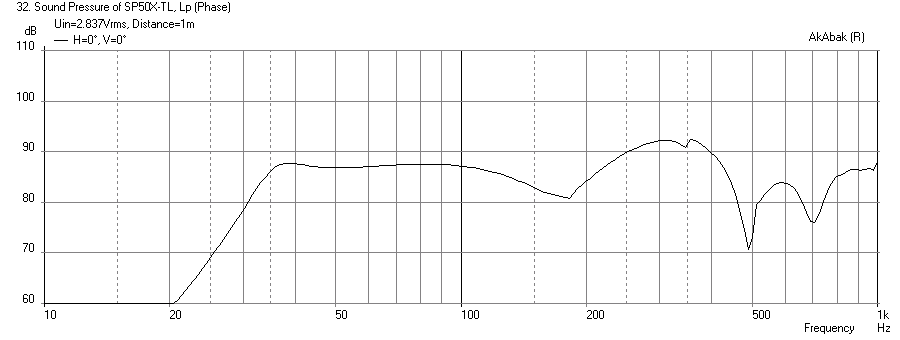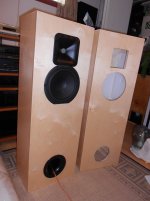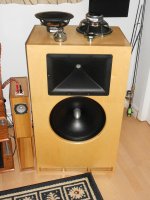These sound so much better. Lower extension and has a fuller low-mid.
Can definitely listen without sub help.
I think they don't need a sub because according to the sims, they reach 35 Hz easily.

Thanks for the kind words X. The old man is going to donate his radial arm saw to my arsenal this weekend. So much easier to crosscut with that thing. Now I just need a decent router and I'll be ready to tackle some quality builds by this fall/winter. My mind is racing and the Mrs.' is shuttering.
The Mrs is worried about where all the speaker builds will go? You can sell them to friends. I think people will be really amazed at the sound quality of full range drivers. You can't buy this in a store like Best Buy. Do you have a mic and download Holmimpulse. I am curious what the freq resp actually measures out to be.
The AMLTL method also works for initial sizing of a Met
I needed to optimize the parameters for a Met with a new driver and used this Accidental MLTL technique to come up with the initial size parameters, and it ended up working out almost perfectly after I ran the simulation in AkAbak. Prezden had some Aura NS3-193 high excursion full range drivers that he wanted to use in a bipole Met. I put the T/S params in WinISD and used the default tuning freq but increased the default volume from 14.1 liters to a round 15 liters to get a little more bass extension. Using the formula for calculating the volume of an obelisk (average of top and bottom areas x length) I came up with the upper and lower dimensions after selecting a 40 in length. The vent length in WinISD was 5.35 in and I increased it to a round 5.5 in. I played with the driver location in the sim to reduce the peaks and dips but that was about all the simulation was used for. Had I left it at the default halfway distance for a Met it would have worked pretty well still. Anyhow the results of the sim are in this thread: http://www.diyaudio.com/forums/full-range/238068-help-bipolar-metronome.html
The NS3-193's can go pretty low for a 3 in driver - about 48 Hz.

I needed to optimize the parameters for a Met with a new driver and used this Accidental MLTL technique to come up with the initial size parameters, and it ended up working out almost perfectly after I ran the simulation in AkAbak. Prezden had some Aura NS3-193 high excursion full range drivers that he wanted to use in a bipole Met. I put the T/S params in WinISD and used the default tuning freq but increased the default volume from 14.1 liters to a round 15 liters to get a little more bass extension. Using the formula for calculating the volume of an obelisk (average of top and bottom areas x length) I came up with the upper and lower dimensions after selecting a 40 in length. The vent length in WinISD was 5.35 in and I increased it to a round 5.5 in. I played with the driver location in the sim to reduce the peaks and dips but that was about all the simulation was used for. Had I left it at the default halfway distance for a Met it would have worked pretty well still. Anyhow the results of the sim are in this thread: http://www.diyaudio.com/forums/full-range/238068-help-bipolar-metronome.html
The NS3-193's can go pretty low for a 3 in driver - about 48 Hz.

Bill,
Yes, I believe a well designed MLTL controls the cone better than the equivalent BR with same volume and vent dimensions, As far as comparing with a non mass loaded TL, that depends on the design - is it an expanding or contracting TL, and how it is tuned. If you follow the link of the above sim of the Met, you will see the cone excursion plot it levels off flat lower freq - doesn't increase without bound. That helps protect cone from low freq as long as power is not exceeded.
Regarding your question about the Arteluthe speaker, it is some sort of TL, whether or not the term "air cannon" refers to a constriction for mass loading I don't know. For it's size and number of folds, only reaching 40 Hz is not so impressive. Do you really need 700 watts? Compare the measured response to that of my in wall MLTL both reach 40 Hz but I don't have the 6 to 10dB drop from below 100 Hz to 40 Hz. Sounds like it can use some BSC. I can't believe how much they charge for premium speakers - a great reason to DIY.
Yes, I believe a well designed MLTL controls the cone better than the equivalent BR with same volume and vent dimensions, As far as comparing with a non mass loaded TL, that depends on the design - is it an expanding or contracting TL, and how it is tuned. If you follow the link of the above sim of the Met, you will see the cone excursion plot it levels off flat lower freq - doesn't increase without bound. That helps protect cone from low freq as long as power is not exceeded.
Regarding your question about the Arteluthe speaker, it is some sort of TL, whether or not the term "air cannon" refers to a constriction for mass loading I don't know. For it's size and number of folds, only reaching 40 Hz is not so impressive. Do you really need 700 watts? Compare the measured response to that of my in wall MLTL both reach 40 Hz but I don't have the 6 to 10dB drop from below 100 Hz to 40 Hz. Sounds like it can use some BSC. I can't believe how much they charge for premium speakers - a great reason to DIY.
Last edited:
And is this a type of MLTL design? About
It's the latest version of what Gemme Audio (now that company's defunct) sold a few years back. AFAIK, it's an ML horn, the 'air cannon' appearing to be another way of saying 'duct', 'vent' or similar.
For it's size and number of folds, only reaching 40 Hz is not so impressive. Do you really need 700 watts? Compare the measured response to that of my in wall MLTL both reach 40 Hz but I don't have the 6 to 10dB drop from below 100 Hz to 40 Hz. Sounds like it can use some BSC. I can't believe how much they charge for premium speakers - a great reason to DIY.
40Hz is about par for the course.
Re the power, it depends. All other things being equal, the more clean power you have in-hand, the more room you have to manoeuvre. Just as an interesting example, do the maths for the power you would need if you listened to a point-source speaker that is rated at 85dB 1m/w sensitivity from 4m away, at an average of 85dB SPL, but require +20dB dynamic peaks because you like orchestral music (some is actually +30dB, but we won't set our sights quite so high).
In practice, you will almost certainly have a similarly apparently dodgy LF response given that in 99.999% of domestic situations the room dominates < ~300Hz, although the comparison is essentially apples / oranges given the utter dissimilarity of the loading, drive units, design goals and everything else for that matter. I rather doubt it's an issue with baffle-step since it appears to have an F3 of ~100Hz, which would imply a baffle about 45in wide. They state it's a typical in-room plot; the data provided isn't sufficient to make any realistic assessment, so I wouldn't pay it all that much attention.
Last edited:
I can't believe how much they charge for premium speakers - a great reason to DIY.
its funny to recognize v basic drivers in 'high end' audio, albeit good units like Peerless nomex etc
+26dB from 85dB requires 2^8.67 or 407 watts. Point well taken - I guess to do classical right you need watts and a driver/speaker combo that can handle it. I have a hard time getting designs that can handle that much power without exceeding xmax. Maybe the Peerless Nomex driver has huge xmax? Although the Karlson is one if the few designs I have seen that really limit xmax for given power applied.
Last edited:
And the rest, since the criteria was 4m & SPLs from a point source drop at -6dB for every doubling of distance.
If you want to do large orchestral material at 'realistic' (viz. 'live') SPLs, given that it can hit > 120dB at the listening position on dynamic peaks, then realistically, a system sensitivity of > 100dB is needed. Most people don't have either the money, space or inclination to go that far though (although space isn't necessarily such an issue with a bit of cunning applied for built-in systems).
If you want to do large orchestral material at 'realistic' (viz. 'live') SPLs, given that it can hit > 120dB at the listening position on dynamic peaks, then realistically, a system sensitivity of > 100dB is needed. Most people don't have either the money, space or inclination to go that far though (although space isn't necessarily such an issue with a bit of cunning applied for built-in systems).
. Maybe the Peerless Nomex driver has huge xmax?
Sonus Faber are using Peerless Nomex drivers in at least one design; the Gemme Audio speakers were using Silver Flute wool cones
its funny to recognize v basic drivers in 'high end' audio, albeit good units like Peerless nomex etc
True; nothing wrong with that though, since once a good basic standard is achieved, it's more about implementation, & especially the XO where most of the work at voicing a multiway speaker occurs. TBH, I'd regularly take some of the more modestly priced 'sensible' units over the mega-price, supposedly 'high end' drivers.
Last edited:
I'd regularly take some of the more modestly priced 'sensible' units over the mega-price, supposedly 'high end' drivers.
couldnt agree more, there's even a $10 Dayton tweeter that sound wise wd give a SS 9700 a scare
Seeing how 45$ drivers were being used in speakers I owned that retailed for 1800$ in the mid 90ies was a good push for me to DIY. 🙂
The Peerless Nomex is pretty good. And keeping with this thread's topic, I have the 8" in not-entirely-accidental MLTL.




It can get fairly loud with its generous Xmax, but sensitivity is not so high with BSC accounted for. The HF is a (really padded-down 🙂 ) BMS 4540ND on JBL PT waveguide.
These are more like it for full-scale stuff 🙂 :

The TD15M that is - not the FF85WK, though very good in its own right. 😉
IG
The Peerless Nomex is pretty good. And keeping with this thread's topic, I have the 8" in not-entirely-accidental MLTL.




It can get fairly loud with its generous Xmax, but sensitivity is not so high with BSC accounted for. The HF is a (really padded-down 🙂 ) BMS 4540ND on JBL PT waveguide.
These are more like it for full-scale stuff 🙂 :

The TD15M that is - not the FF85WK, though very good in its own right. 😉
IG
Last edited:
Thanks, that's my most serious effort at passive Xover design so far, still very much a novice. 14 parts total per speaker. The TD15M box is bi-amped with miniDSP.
IG
IG
Your box with the TD15M looks very nice. How does this box sound bi-amped? My final question is - isn't it almost less expensive to bi-amp and DSP rather than build 14 part count crossovers?
I see you also fly fish - one of my favorite hobbies apart from DIY... 🙂
I see you also fly fish - one of my favorite hobbies apart from DIY... 🙂
Your box with the TD15M looks very nice. How does this box sound bi-amped? My final question is - isn't it almost less expensive to bi-amp and DSP rather than build 14 part count crossovers?
I see you also fly fish - one of my favorite hobbies apart from DIY... 🙂
Sounds awesome! I barely feel any cone movement with a comfortable level of fairly deep bass. I have 2 ~130W amps driving it and though its is a good low-level performer, it likes more juice whenever I give it. HF is BMS 4550 and QSC waveguide, real good stuff too.
The miniDSP 2x4 is a good solution indeed. Extremely flexible and you don't need to have tons of passive parts to tweak if you're not happy. It does not ruin listening to vinyl records for me. It is very easy to spend more on passive parts, even with just basic quality stuff.
IG
+26dB from 85dB requires 2^8.67 or 407 watts.
Hmm, 85-105 = +20 dB and 1-4 m = 20log[4/1] = ~ +12.04 dB or ~ +32.04 dB @ the LP = 2^[32.04/3.01] = ~1601 W peak transients, which of course no typical wide BW driver can dissipate for more than a split second before 'letting its smoke out' and since the amp typically is rated for only a fraction of this, system SQ in this scenario is ~totally dependent on the perceived quality of it's protection [clipping] circuit's performance characteristics combined with the system's HF performance ability to accurately reproduce the transient’s leading edge.
FWIW, on the long gone basslist we discussed the crude measurements taken at my ‘dawn of the digital age’ that forced me to switch to a high SQ 300 W/channel amp to drive very eff. ~70 Hz mid-bass horns and separate sub system after I found that there was up to +30dB 'fast' transients on some classical CDs in the ~250-500 Hz BW [mostly around 300 Hz IIRC and why a dip in the response here is doing your amp a favor], though there were a couple of pipe organ symphony CDs that came out later with up to +28dB down in the mid-bass and +32 dB higher up IIRC.
IIRC it was Nick McKinney of Lambda fame that used MLS or similar to find that these ultra fast transients were hard clipped, lending some credibility to the claimed higher actual peaks, so just having a very efficient system isn’t enough, one must have flat HF well beyond 20 kHz as this article has shown: There's life above 20 kilohertz! A survey of musical instrument spectra to 102.4 kHz
With some movie soundtracks approaching 0 Hz [DC], multiple driver IB sub systems along with high output ultrasonic super-tweeters are now required for those who can afford to reproduce the widest BW material available at the levels the director and/or producer intended.
Never even imagined we would come this far in my lifetime, much less be reasonably affordable.
GM
Every 3 dB is doubling of power right? 85 dB sensitivity at 1 m 1 watt is same as +6dB at 4 m away hence 6 dB + 20 dB for 26 dB. 26 dB/3dB per doubling is same as 2^8.67 = 407. 1600 watts would be to double this two more times or +32dB.
That's why pro audio drivers start at 98 dB instead of 85 dB. That 13 dB is huge in reduction of watts required to pump 120 dB to audience.
That's why pro audio drivers start at 98 dB instead of 85 dB. That 13 dB is huge in reduction of watts required to pump 120 dB to audience.
Last edited:
- Home
- Loudspeakers
- Full Range
- Accidental MLTL Technique